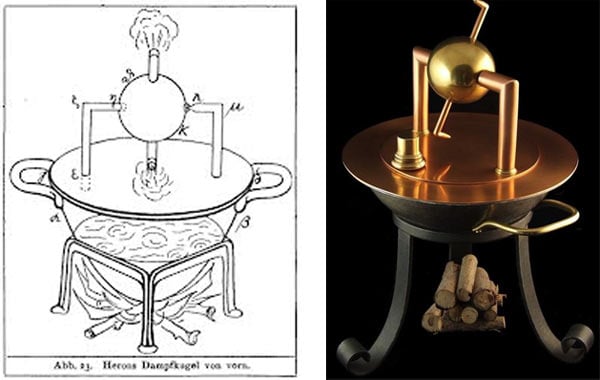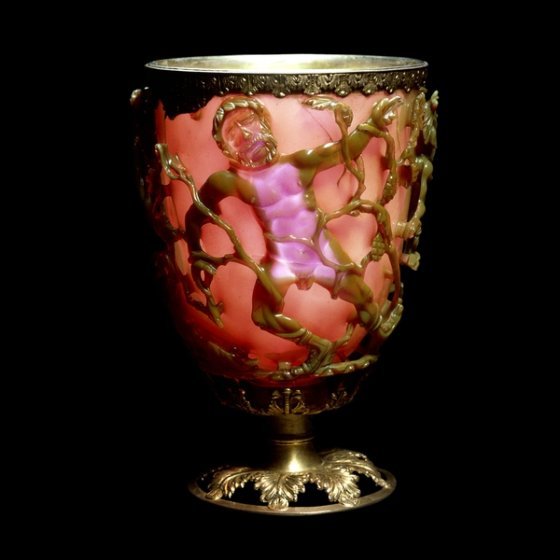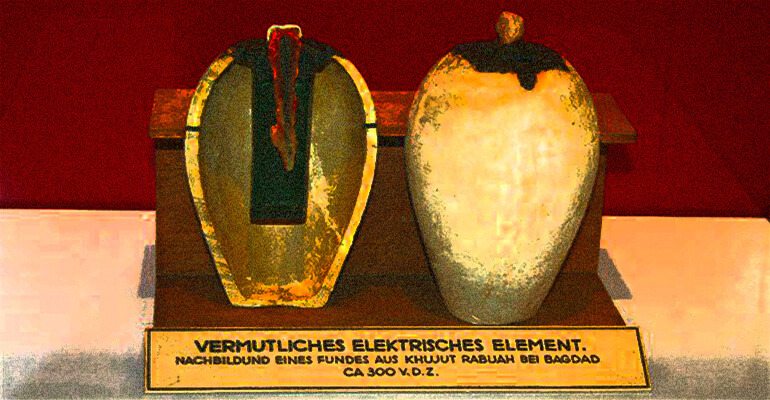Advanced Ancient Technologies Way Ahead of Their Time
Modern humans are the best humans. Just look back at those primitive troglodytes from hundreds of years ago: what a bunch of idiots. Probably don't even know how to work an iPhone. Truly, we are superior in every way,
Some of these sophisticated ancient inventions were later re-invented by our modern society, but not all. There is no doubt ancient people possessed highly advanced knowledge in a number of areas.
5. Viking Compasses Nearly as Good as GPS

Navigating the ocean back in ancient times was extremely tricky, given that they didn't have GPS, compasses, or even shuffleboard on those rickety old cruise ships. If you wanted to go from, say, Europe to the Americas back then, you were just as likely to crash into Madagascar since all that water looks the same out there. Scientists were puzzled about how the Vikings were consistently able to travel in a totally straight line from Norway to Greenland and back, some 1,600 miles, while the rest of the world was rowing around in circles, too proud to ask the passing mermaids for directions. Then, in 1948, they found an ancient Viking artifact under an 11th-century convent and concluded it was a shockingly advanced compass.

ften regarded as ruthless robbers, the Vikings were also impressive mariners capable of traversing the North Atlantic along a nearly straight line. Now, new interpretations of a medieval compass suggest the sea robbers may have skillfully used the sun to operate the compass even when the sun had set below the horizon.
The remains of the supposed compass — known as the Uunartoq disc— were found in Greenland in 1948 in an 11th-century convent. Though some researchers originally argued it was simply a decorative object, other researchers have suggested the disc was an important navigational tool that the Vikings would have used in their roughly 1,600-mile-long (2,500 kilometers) trek from Norway to Greenland.
Though only half of the wooden disc remains, it is estimated to have been roughly 2.8 inches (7 centimeters) in diameter with a now-lost central pin that would have cast a shadow from the sun indicative of a cardinal direction. [Images: Viking Twilight Compass Helps Navigate North Atlantic]
Researchers based at Eötvös Loránd University in Hungary have studied the fragment in detail. They concluded that although the disc could have functioned as a single entity, it was more likely used in conjunction with other tools — including a pair of crystals and a flat, wooden slab — to help navigate when the sun was low in the sky or even below the horizon.
4. The ancient invention of the steam engine by the Hero of Alexandria

Heron Alexandrinus, otherwise known as the Hero of Alexandria, was a 1 st century Greek mathematician and engineer who is known as the first inventor of the steam engine. His steam powered device was called the aeolipile, named after Aiolos, God of the winds. The aeolipile consisted of a sphere positioned in such a way that it could rotate around its axis. Nozzles opposite each other would expel steam and both of the nozzles would generate a combined thrust resulting in torque, causing the sphere to spin around its axis. The rotation force sped up the sphere up to the point where the resistance from traction and air brought it to a stable rotation speed. The steam was created by boiling water under the sphere – the boiler was connected to the rotating sphere through a pair of pipes that at the same time served as pivots for the sphere. The replica of Heron’s machine could rotate at 1,500 rounds per minute with a very low pressure of 1.8 pounds per square inch. The remarkable device was forgotten and never used properly until 1577, when the steam engine was ‘re-invented’ by the philosopher, astronomer and engineer, Taqu al-Din.
Heron Alexandrinus, or Hero of Alexandria as he was often known, was a Greek born in 10AD in Alexandria, now part of Egypt, and the second largest city after Cairo. Little is known about the life of Heron, however, we are aware that he was born to Greek parents that migrated to Alexandria after the conquest of Alexander the Great. Heron was a mathematician and an engineer considered to be one of the greatest inventors of ancient times. During the era in which Heron lived, the great Library of Alexandria was in its glory and Heron is believed to have taught at the Museum of Alexandria, a place for scientists and scholars to meet and discuss
Alexandria 300 years before him, known as Ktesibios, the first to write about the science of compressed air.
But what is an aeolipile? It is a sphere that is positioned in such a way that it can rotate around its axis. Nozzles that are opposite to each other would expel steam and both of the nozzles would generate a combined thrust resulting in torque, causing the sphere to spin around its axis. The rotation force speeds up the sphere up to the point where the resistance from traction and air brings it to a stable rotation speed. The second video at the end of this article demonstrates how it works.
Why the First Steam Engine is Important
What’s interesting about Hero’s invention is that he created it well before the Industrial Revolution that took place in parts of the world in the 1700’s and 1800’s. This means that the Ancient Greeks were capable of advanced mathematical, scientific, and mechanical thought, which enabled them to see the world differently. They understood that mathematical and scientific theories provided the foundation to create these wonderful devices.Although it would be some time before the steam engine was applied in a more practical way, the implications of what Hero accomplished are great. He showed that man is capable of creating great inventions, even when the use of them isn’t immediately obvious.
3. 1,600-year-old goblet shows that the Romans used nanotechnology

Despite that nanontechnology represents a new rather modern concept and is related to ultrahigh precision and ultra-small sizes, the term "nano" is old and comes from the Greek word "nanos" and means "dwarf"
This
extraordinary Lycurgus cup is the only surviving complete example made
from dichroic glass, which changes colour when held up to the light.
When light is shone through the body of the cup it turns from opaque
green to a glowing translucent red. The glass contains tiny amounts of
colloidal gold and silver, which give it these unusual optical
properties. Image credit: British Museum
Knowledge about metallic nanoparticles have already been used since
ancient times, especially regarding the unusual colors seen in the
ancient glass and ceramic objects. It is believed that the use of
metallic nanoparticles started with the beginning of glass-making in
Egypt and Mesopotamia that dates back in the fourteenth and thirteenth
centuries BC.The most remarkable example of the use of metallic nanoparticles is Lycurgus Cup, a piece of Roman glasswork dating from the fourth century CE, showing a mythological scene depicting the legend of King Lycurgus.
"....Glass-producing techniques were highly developed and workmanship was superb.
In the Lycurgus Cup, nowhoused in the British Museum, the 324 AD victory of Constantine over Licinius in Thrace was represented through the death of an enemy of Dionysius, Lycurgus, who is shown being overcome by vines...." Daniel L. Schodek, Paulo Ferreira, Michael F. Ashby write in their book "Nanomaterials, Nanotechnologies and Design".
2. The Baghdad Battery

Let’s start off with one of the most famous archeological finds on the subject. Discovered in the 1930s in a region called Khujut Rubu’a just outside Baghdad, the so-called “Baghdad Battery” was a wonder to behold considering that electricity and its uses would not have been discovered 2000 years after these batteries came into existence.
The batteries discovered consisted of a clay jar with an asphalt stopper. Through the center of the stopper ran an iron rod that was surrounded by a copper cylinder inside the jar. It is believed that if the jar was filled with an electrolytic solution like vinegar or lemon juice, the battery would be able to produce at least 1.1 volts of electricity.
A volt may not be enough to power a home or a machine that relied on electricity, but archeologists and historians believe that it may have been used for purposes of electroplating since artifacts with very thin layers of gold and silver have also been unearthed in digs; artifacts that may reinforce the notion that the batteries were ancient power tools.
On the other side of the spectrum, some experts disagree that the Baghdad Batteries are, in fact, “batteries” since they found no conclusive evidence as to where they might be used or what they might be used for.
Some scholars claim that the jars were more likely to be a sophisticated means of keeping scrolls and papyri and that the acidic residue found at the bottom of the clay jars were nothing more than decomposed scrolls and papyri. Whatever the claim, the Baghdad Batteries still confound and astound historians and archeologists to this very day.
1. Incredible Ancient Metallurgical Wonders

The Antediluvians had technologies that matched our own; there are also serious indications that in certain areas they even possessed extraordinary knowledge, which has only hardly been nudged by our present-day science.
Highly advanced hardening techniques of the ancients as well as ancient castings of large pieces were widespread in antiquity. Our ancestors were in possession of an extremely sophisticated scientific knowledge of metalworking from an earlier civilization and evidence of this knowledge was found in different parts of the world.
China with a long history in metallurgy, was the earliest civilization that manufactured cast iron and some of the ancient Chinese feats of casting iron are so impressive as to be almost unbelievable.
Ancient Indians, for example, produced iron capable of withstanding corrosion, most likely due to the high phosphorus content of the iron produced during those times.
A column of cast iron 23 feet (7 meters) high, weighing approximately 6 tons with diameter of 16.4 inches stands in the courtyard of Kutb Minar in Delhi, India.
An inscription in the Sanskrit language informs that the column was originally erected in the temple of Muttra and capped with Garuda – “Messenger of the Gods” – an image of the bird incarnation of the god Vishnu, the Indian god known as “The Preserver”.
messagetoeagle.com
ancientpages.com
cracked.com
ancient-origins.net
beyondsciencetv.com

